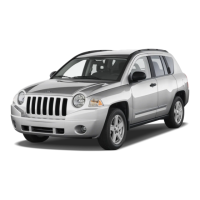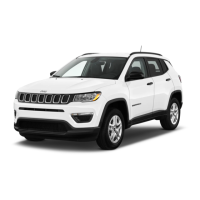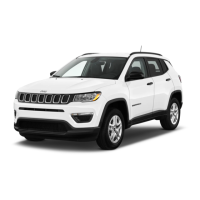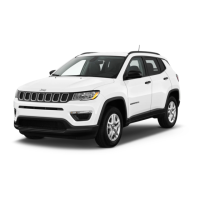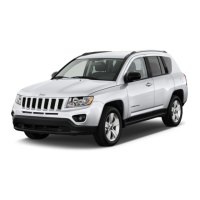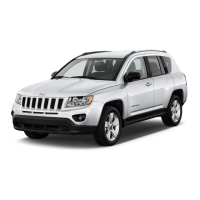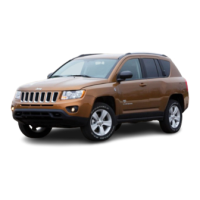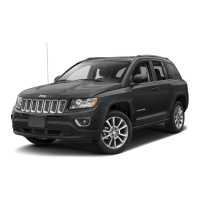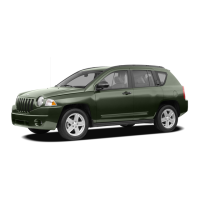
Do you have a question about the Jeep Compass 2014 and is the answer not in the manual?
| Brand | Jeep |
|---|---|
| Model | Compass 2014 |
| Category | Automobile |
| Language | English |
Discusses the higher rollover risk for utility vehicles and safe driving practices.
Guidance on navigating the owner's manual using the table of contents and index.
Highlights warnings for operating procedures and cautions against vehicle damage.
Details the location and importance of the Vehicle Identification Number (VIN).
Warns about the risks and consequences of modifying or altering the vehicle.
Discusses key codes, removal, locking doors with a key, and key-in-ignition reminders.
Explains the Sentry Key Immobilizer System, its operation, and key replacement.
Details the vehicle security alarm's monitoring, activation, and disarming procedures.
Covers RKE functions like unlocking doors, liftgate, and activating the panic alarm.
Explains how to use the remote start system and its abort messages.
Describes manual, power, auto lock/unlock doors, and child-protection door lock system.
Covers power window switches, auto-down feature, and window lockout switch.
Explains how to unlock and open the liftgate.
Details seat belts, airbags, active head restraints, and child restraint systems.
Covers inside day/night mirror, automatic dimming mirror, and outside mirror adjustments.
Explains how to adjust driver and passenger side outside mirrors.
Describes how the outside mirrors are hinged and can be moved to resist damage.
Details the location and operation of the power mirror control.
Explains how heated mirrors melt frost or ice, activated by the rear window defroster.
Describes how to use the vanity mirror.
Explains that sun visors can be extended for more coverage.
Details the voice-activated, hands-free Uconnect Phone system for mobile communication.
Explains the operation of the voice command system for controlling vehicle features.
Identifies and labels the main components of the vehicle's instrument panel.
Illustrates the layout of the instrument cluster, including gauges and indicators.
Provides detailed descriptions of various warning lights and indicators on the instrument cluster.
Explains the mini-trip computer features for trip information and temperature display.
Details the functions and displays of the Electronic Vehicle Information Center (EVIC).
Provides steps for starting the vehicle, including seat/mirror adjustment and seat belt fastening.
Explains the function and connection of the engine block heater for cold weather starts.
Covers manual transmission operation, including shift patterns and recommended speeds.
Details automatic transmission operation, including gear ranges and shift interlock systems.
Explains the AutoStick feature for manual shift control in automatic transmissions.
Describes the full-time, on-demand four-wheel drive (4WD) system and its activation.
Offers tips for driving utility vehicles on paved roads, considering design characteristics.
Provides guidance for driving on various off-road terrains, emphasizing control and judgment.
Explains the location and operation of the hazard warning flasher switch.
Provides actions to reduce overheating potential and steps to take if the engine overheats.
Addresses automatic transmission oil overheating and the resulting indicator light and vehicle behavior.
Details proper lug nut/bolt torque for wheel mounting and inspection of the mounting surface.
Provides crucial safety warnings and instructions for changing a tire, including jack usage.
Explains the components and operation of the TIREFIT kit for temporary tire sealing.
Outlines the procedures and safety precautions for jump-starting a vehicle with a discharged battery.
Describes using a rocking motion and ESC Off mode to free a stuck vehicle.
Explains the procedure to temporarily move the shift lever if it cannot be moved from PARK.
Provides procedures for towing a disabled vehicle using a commercial wrecker service.
Identifies components in the engine compartment for the 2.0L engine.
Identifies components in the engine compartment for the 2.4L engine.
Explains the OBD II system, Malfunction Indicator Light (MIL), and loose fuel filler cap messages.
Details emissions inspection requirements and the OBD II system readiness test.
Recommends using genuine MOPAR parts for maintenance and repairs.
Emphasizes using authorized dealer service for qualified personnel and tools.
Covers required maintenance services, including engine oil, filters, and battery maintenance.
Provides instructions on checking and changing engine oil, including oil selection and viscosity.
Details engine oil filter replacement and selection recommendations.
Refers to maintenance schedule for proper engine air cleaner filter intervals.
Information on the maintenance-free battery, including safety precautions.
Covers air conditioner checks, service, and filter replacement.
Explains periodic lubrication of locks, pivot points, and hinges with lithium-based grease.
Provides instructions on cleaning wiper blades and windshield for optimal performance.
Details the location of the washer fluid reservoir and proper fluid selection.
Emphasizes proper maintenance of the exhaust system for carbon monoxide protection and fire prevention.
Covers coolant checks, drain/flush/refill procedures, selection, and pressure cap warnings.
Details brake system inspection, master cylinder fluid check, and brake fluid recommendations.
Provides an overview of scheduled maintenance intervals based on mileage, time, and operating conditions.
Presents a detailed maintenance schedule chart with inspections and additional maintenance items.
Offers advice on preparing for service appointments and communicating with service advisors.
Provides contact information for Chrysler Group LLC and Chrysler Canada Inc. Customer Centers.
Explains how customers with hearing or speech impairments can contact the manufacturer.
Details information about purchased service contracts and how to contact customer service for questions.
Refers to the Warranty Information Booklet for terms and provisions of Chrysler Group LLC warranties.
Recommends using genuine MOPAR parts for optimal vehicle operation.
Instructs owners on how to report safety defects to NHTSA and provides contact information.
Highlights special design considerations for installing radio transmitting equipment to ensure system immunity.
Details proper positive and negative power connection procedures for radio transmitting equipment.
Provides guidance on antenna mounting locations and precautions regarding magnet bases affecting compass accuracy.

